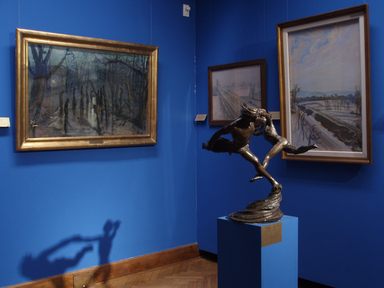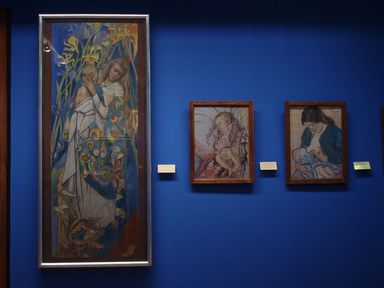
Stanisław Wyspiański’s Study Room within the Gallery of
Polish Painting
 The
present exposition of the Gallery of Polish Painting, opened in 1992
after general renovation, was conducted on the basis of the factual
concept by dr Agnieszka Morawińska, curator of the Gallery of Polish
Painting in the years 1980-1992. In nine halls and ten rooms one can
find 400 paintings. Krzysztof Burnatowicz was the author of the
artistic concept of the exposition. Throughout the history the
Gallery has occupied the same location, which has been assigned to it
since the opening of the new building of the Museum in 1938.
The
present exposition of the Gallery of Polish Painting, opened in 1992
after general renovation, was conducted on the basis of the factual
concept by dr Agnieszka Morawińska, curator of the Gallery of Polish
Painting in the years 1980-1992. In nine halls and ten rooms one can
find 400 paintings. Krzysztof Burnatowicz was the author of the
artistic concept of the exposition. Throughout the history the
Gallery has occupied the same location, which has been assigned to it
since the opening of the new building of the Museum in 1938.In the seventh room there is a hall devoted to Stanisław Wyspiański’s oeuvre. Excellent pastels stand out from twenty presented artist’s works, among others: two self-portraits dated 1894 and 1902 and one from the series Materhood, depicting artist’s wife Teofila Pytko, breastfeeding their son Staś. The examples of excellent portraits being in the permanent exposition are: Helenka’s Head, Portrait of Józefa Krzyształowicz, Portrait of Konrad Rakowski. The most famous artist’s works are pastels: Sheaves dated 1898-1899, presenting the dream of nature, the metaphor of the nation dreaming in captivity, Madonna and Child from 1904, fragment of the project of stained glass window for the cathedral in Lvov and View of Kościuszko Mound from a window in the artist's studio made in the last years of artist’s life.

The exposition of Wyspiański’s works is accompanied with the bronze sculpture by Sławomir Celiński (1852-1918) Whistle and Whizz (Świst i Poświst) dated around 1910.
The Gallery of Polish Painting is a part of the permanent exposition in the National Museum in Warsaw. It is located on the first floor of the building. The Gallery is open from Tuesday to Sunday. The ticket for permanent expositions is 12 PLN (adults) and 7 PLN (students). Family ticket for permanent expositions is 25 PLN. On Saturdays the entrance to permanent galleries is free.
GALLERY OF POLISH PAINTING
Halls given in the order in conformity with the direction of the visit
Hall I. Old Polish painting
Room 1. Painting
Hall II. Enlightenment. Classicism
Room 2. Enlightenment. Vilnus classicism
Room 3. Miniatures
Hall III and Room 5. Romanism. Towards the academism
Room 4. Towards realism
Hall IV. Matejko. Historical painting
Hall V. Academic painting
Room VI. Realism. Munich School
Room VII. Realism. Towards impressionism
Room 7. Stanisław Wyspiański
Room 8. Olga Boznańska
Hall IX. Symbolism
Room 6. Young Poland
Room 9. Witold Wojtkiewicz
.
translated
by Anna Kiełczewska
